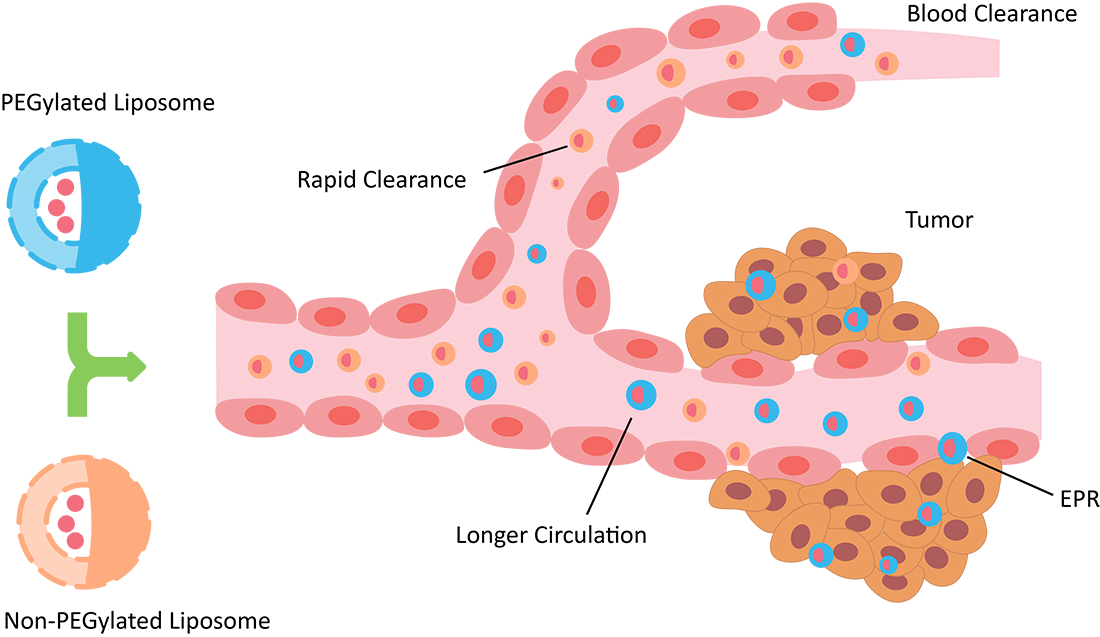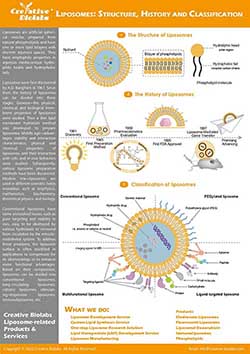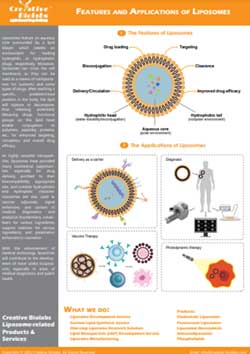Long Circulating Liposome Development Service
Background Functions Applications Services Platforms Novel Advances FAQs Resources
Creative Biolabs offers a comprehensive range of services focused on the development of long circulating liposomes. These liposomal formulations are designed to extend the time liposomes remain in the bloodstream, improving the efficacy and performance of the encapsulated drugs. With extensive expertise and cutting-edge technology in the field of liposomes, Creative Biolabs provides customizable solutions tailored to meet specific project requirements. Our company's scientific team ensures the development of long circulating liposomes with optimized stability, extended circulation time, and targeted delivery capabilities.
What is a Long Circulating Liposome?
Long circulating liposomes are advanced drug delivery vehicles designed to extend their residence time in the bloodstream. Unlike conventional liposomes, which are quickly cleared from circulation by the mononuclear phagocyte system (MPS), long circulating liposomes are modified with hydrophilic polymers, such as polyethylene glycol (PEG), to avoid recognition and capture by immune cells. This modification allows the liposomes to circulate for extended periods, improving drug accumulation in target tissues and reducing off-target effects.
Long circulating liposomes are typically composed of a lipid bilayer that encapsulates either hydrophilic or hydrophobic drugs. By shielding the liposomes from immune detection, PEGylation enhances their stability, increases their half-life, and allows for sustained drug release. This makes long circulating liposomes particularly useful in delivering bioactive compounds that require precise targeting.
 Fig.1 PEGylation for long circulating liposome
Fig.1 PEGylation for long circulating liposome
Functions of Long Circulating Liposomes
Long circulating liposomes serve several important functions in drug delivery:
-
Extended circulation time: By incorporating PEGylation or other hydrophilic coatings, long circulating liposomes remain in the bloodstream longer, increasing the opportunity for delivery to target tissues.
-
Reduced immune clearance: PEGylation helps prevent recognition by the immune system, reducing clearance by macrophages and prolonging the liposomes' half-life.
-
Enhanced drug stability: The encapsulation of drugs within liposomes protects them from degradation, improving the stability of sensitive compounds.
-
Targeted delivery: Long circulating liposomes are designed to take advantage of the enhanced permeability and retention (EPR) effect, which allows them to accumulate in tumors or inflamed tissues with leaky vasculature.
-
Improved pharmacokinetics: These liposomes modify the pharmacokinetic profile of bioactive compounds, ensuring their controlled release and extended presence in the body.
 Fig.2 Pharmacokinetics of PEGylated liposomes
Fig.2 Pharmacokinetics of PEGylated liposomes
Applications of Long Circulating Liposomes
Long circulating liposomes are utilized in various scientific and medical research fields, where extended delivery and targeting capabilities are required. These applications involve enhancing the delivery of bioactive compounds, improving stability, and reducing off-target effects. Below is a summary of some key areas where long circulating liposomes are applied:
|
Application
|
Description
|
|
Cancer Research
|
Long circulating liposomes are designed to accumulate in tumors due to their enhanced permeability, making them suitable for carrying bioactive molecules that require precise delivery to tumor sites.
|
|
Antimicrobial Delivery
|
Liposomes protect delicate antimicrobials from degradation, supporting their effective delivery in infection models.
|
|
Gene Delivery Studies
|
These liposomes can encapsulate and deliver genetic material, aiding in research related to gene expression and regulation.
|
|
Immunological Studies
|
Liposomes are used in immunological research to carry immune-modulating agents, facilitating studies on immune responses and modulation.
|
|
Cardiovascular Research
|
Liposomal formulations are used in cardiovascular models to deliver bioactive molecules to regions of interest, such as arterial plaques.
|
What We Can Do About Long Circulating Liposome Development?
Creative Biolabs provides a range of services related to the development of long circulating liposomes. The services are fully customizable to fit client requirements, and the company's team of experts ensures rapid and reliable project completion. The following table highlights the specific services offered. For more details, please feel free to contact us.
|
Service
|
Description
|
|
Formulation Design
|
Customization of liposome formulations, optimizing lipid composition, PEGylation, and drug encapsulation strategies.
|
|
Analysis and Characterization
|
In-depth analysis of liposome properties, including size, charge, stability, and drug loading efficiency.
|
|
Pharmacokinetics Testing
|
Evaluation of how the liposomes distribute, absorb, metabolize, and excrete in biological systems, providing critical data on half-life and bioavailability.
|
|
Stability Testing
|
Assessing liposomal integrity and drug release rates under various conditions, including temperature, pH, and presence of enzymes.
|
|
Targeted Drug Delivery Design
|
Incorporation of targeting ligands to enhance the accumulation of liposomes in specific tissues.
|
|
Scale-up and Manufacturing
|
GMP-compliant production of liposomal drug formulations for preclinical and clinical applications.
|
Platforms Supporting Long Circulating Liposome Development
Creative Biolabs utilizes state-of-the-art platforms to support its long circulating liposome development service. These platforms ensure high precision in formulation, stability testing, and scalability, addressing the unique requirements of each project. Below are the key platforms involved:
-
High-throughput liposome formulation platform: This platform supports rapid screening and optimization of lipid formulations, allowing for efficient testing of multiple variables with minimal experiments. It accelerates formulation development while ensuring accurate results, optimizing key properties such as liposome size, charge, and drug encapsulation efficiency.
-
Dynamic light scattering (DLS) analysis: DLS measures liposome size, zeta potential, and polydispersity, providing precise data on liposome stability. It offers fast, non-invasive measurements, enabling efficient optimization of liposome characteristics for better circulation and delivery in biological environments.
-
In vitro and in vivo stability platforms: These platforms assess liposome stability under physiological conditions, predicting their longevity and behavior in biological fluids. This helps optimize liposomal formulations for extended circulation and ensures reduced degradation before reaching target sites.
-
Targeted delivery systems: This system integrates ligands such as antibodies or peptides into liposomes to enhance targeting specificity. It improves liposome accumulation in target tissues, reducing off-target effects and increasing the precision of delivery in specific research models.
These platforms work synergistically to provide seamless development of long circulating liposomes with high drug encapsulation efficiency and prolonged circulation time.
Novel Advances in Long Circulating Liposome Technology
Recent advances in the field of liposome research have led to the development of novel long circulating liposomes, such as magnetic and cationic liposomes. These innovations improve targeting specificity and delivery efficiency. Magnetic liposomes incorporate iron oxide particles, which allow external magnetic fields to direct the liposomes to specific tissues, while cationic liposomes enhance transfection efficiency in gene delivery.
Other innovations include thermosensitive liposomes, which release their contents at elevated temperatures, making them suitable for hyperthermia research. Additionally, nanotechnology has enabled the production of smaller, more stable liposomes that can cross biological barriers more effectively.
FAQs
How does Creative Biolabs customize long circulating liposomes?
Creative Biolabs offers tailored liposome development services, including the selection of lipid compositions, PEGylation strategies, and encapsulation methods to meet specific client needs.
How does PEGylation improve the circulation time of liposomes?
PEGylation adds a hydrophilic polymer layer to the liposome surface, which reduces recognition and clearance by the mononuclear phagocyte system (MPS). This modification enhances liposome stability in the bloodstream and significantly prolongs its circulation time.
What types of drugs can be encapsulated in long circulating liposomes?
Long circulating liposomes can encapsulate a wide variety of bioactive compounds, including small molecules, proteins, peptides, nucleic acids, and hydrophobic or hydrophilic drugs. This versatility makes them ideal for a broad range of applications in biomedical research.
What is the role of Zeta potential in the stability of long circulating liposomes?
Zeta potential is a key indicator of the surface charge of liposomes. A high absolute value of Zeta potential helps in preventing the aggregation of liposomes by providing electrostatic repulsion between particles. This improves the stability of the liposomal formulation in various environments.
Resources

For Research Use Only. Not For Clinical Use

 Fig.1 PEGylation for long circulating liposome
Fig.1 PEGylation for long circulating liposome
 Fig.2 Pharmacokinetics of PEGylated liposomes
Fig.2 Pharmacokinetics of PEGylated liposomes



 For Research Use Only. Not For Clinical Use
For Research Use Only. Not For Clinical Use


